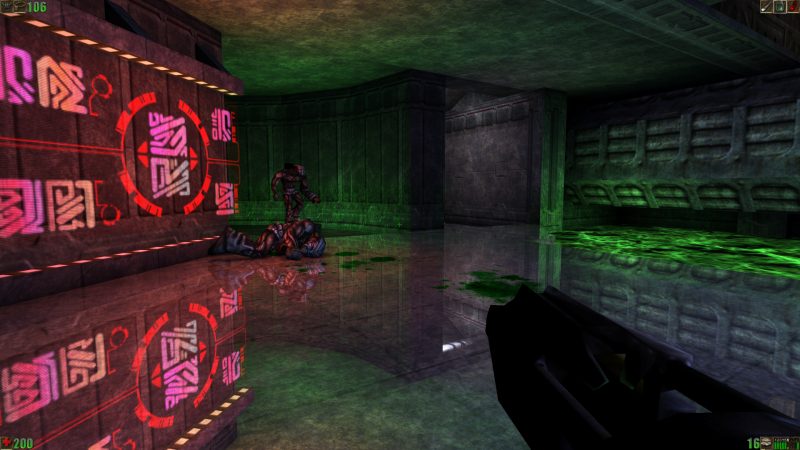O tempora is a series of retrospective posts where I play games from ages before to see if they stood the test of time.
Unreal – the name probably came from just how beautiful the game looked at the time of release. Yet, for me and my friends back in the day the name became a joke – it was “unreal” to make it work with a respectable fps count, unless you had a really powerful PC. And my friends didn’t. So we could either play the game on much lower settings or watch the amazing jaw-dropping slideshow of a game. And that was one of the main reasons why I’ve never actually played the game properly until now. I have played all the “Tournament” games (which I won’t be covering), but both singleplayer Unreal games passed me by. Was the game all looks, or did it really have something good about it?
 Speaking of looks – Unreal still manages to look good today. Of course, to run it with full 1080p you’d need to use either a popular fan made patch, or the fan made DX10 renderer. But even without adding new features to the render and just upping the resolution, the game manages to look quite impressive today. Right from the very beginning it tries to show off it’s real-time reflections, the amazing (for the time) water effect and some nice mix of per-baked and real-time lighting and shading. Of course, by today’s standards the models are simplistic, the textures are very low-res and the initial implementation of mipmaps, pioneered by Unreal Engine to my knowledge, and texture filtering makes a lot of things look rather blurry, but the levels are open and huge and full of the cool effects mentioned above. More importantly, game looks much more impressive than Quake II, which was released less than half a year prior, in pretty much everything, apart from the animation quality. Unreal does include some nice new animation features, including the dodging animations for both enemies and the player, but other than that, animations feel simpler.
Speaking of looks – Unreal still manages to look good today. Of course, to run it with full 1080p you’d need to use either a popular fan made patch, or the fan made DX10 renderer. But even without adding new features to the render and just upping the resolution, the game manages to look quite impressive today. Right from the very beginning it tries to show off it’s real-time reflections, the amazing (for the time) water effect and some nice mix of per-baked and real-time lighting and shading. Of course, by today’s standards the models are simplistic, the textures are very low-res and the initial implementation of mipmaps, pioneered by Unreal Engine to my knowledge, and texture filtering makes a lot of things look rather blurry, but the levels are open and huge and full of the cool effects mentioned above. More importantly, game looks much more impressive than Quake II, which was released less than half a year prior, in pretty much everything, apart from the animation quality. Unreal does include some nice new animation features, including the dodging animations for both enemies and the player, but other than that, animations feel simpler.
More importantly, though, the gameplay itself feels simpler, blander than Quake II. That is despite the huge levels, despite the dodges, despite the simulated animal AI on the levels and the existence of alt. fire on all weapons – a soon to become common feature in all FPS games. In my Quake II article I said, that that game felt like a very in-between FPS, released during the transitional period of when FPS games wanted to be story driven but didn’t really know how – something that got changed after the release of Half-Life. And Unreal fits the same category, but on top of that, feels especially bland to play. Enemies act in a very bullet-sponge way, making most weapons feel useless and lacking any kick, the floatiness of controls and movement doesn’t work well with the singleplayer. At times I felt like the game might be an interesting choice for speedrunners, due to how much more fun it was to attempt to run through the levels avoiding enemies, than to engage in First Person Shooting.
And that is really the biggest issue that is letting Unreal and it’s expansion Return to Na Pali down. Both of them feature some pretty levels, which mix jungle-like planet with medieval castle aesthetic. There are clever attempts to tell the story via the “universal translator” (which is, essentially, a way to have text logs without them being text logs in name) and the expansion even attempts (rather miserably) to have voice acted cutscenes. The weapon concepts are solid and Flak Cannon would become a staple of the entire series, but most of them feel ineffective against enemies, who almost never even flick when being shot at. Unlike a very, and I’m sorry to use this word, visceral combat in Quake 1 and 2, shooting enemies in Unreal feels boring.
As such, Unreal would probably forever be remembered more for the impressive engine it was made on and the actually fun multiplayer-only Tournament series. Funny how simply changing enemies into real players and slightly rebalancing the health and damage makes the same gameplay feel completely different and much more fun. As a singleplayer experience, though, Unreal Gold isn’t very fun to play today. Still love that upgradable dispersion pistol animations, though.



